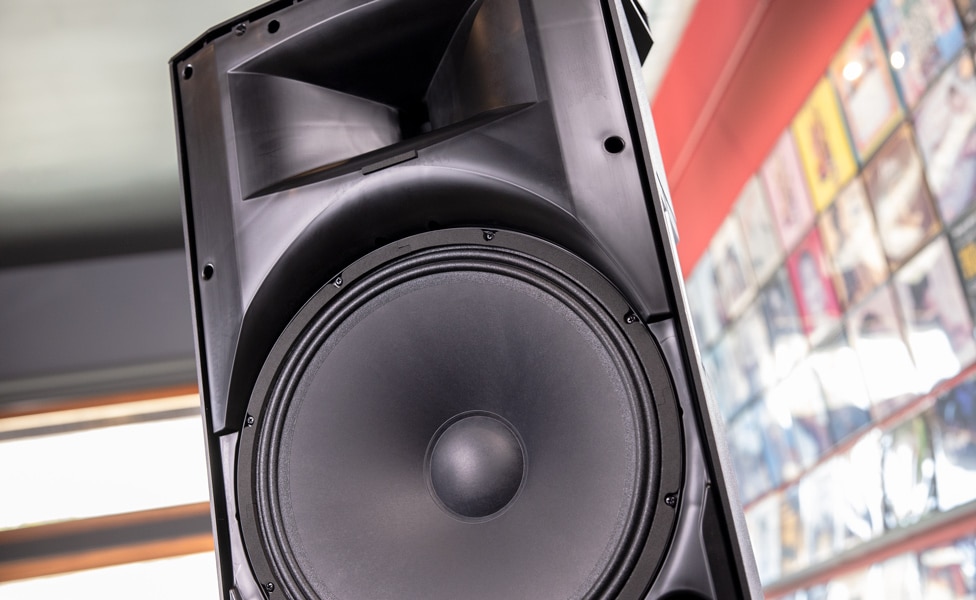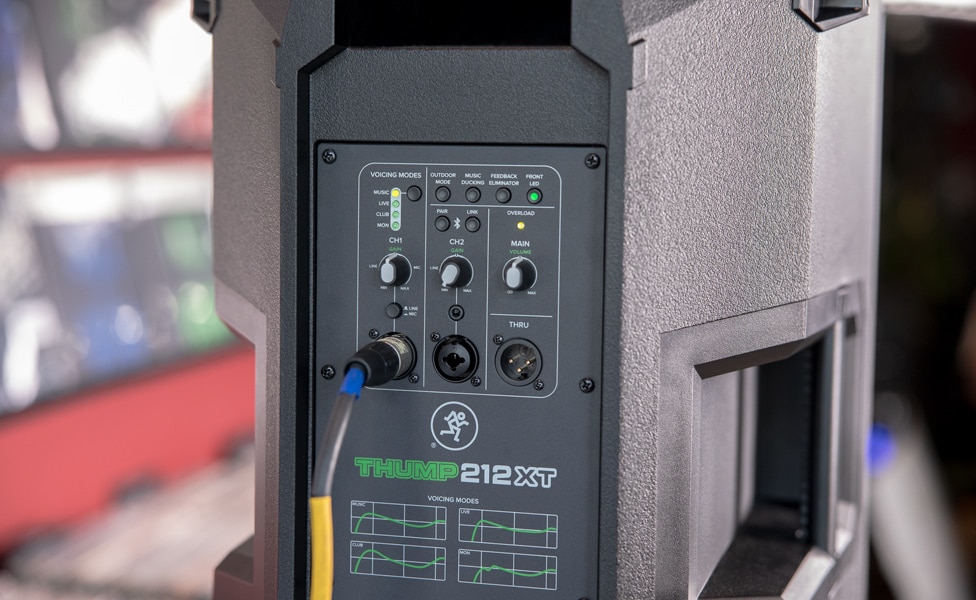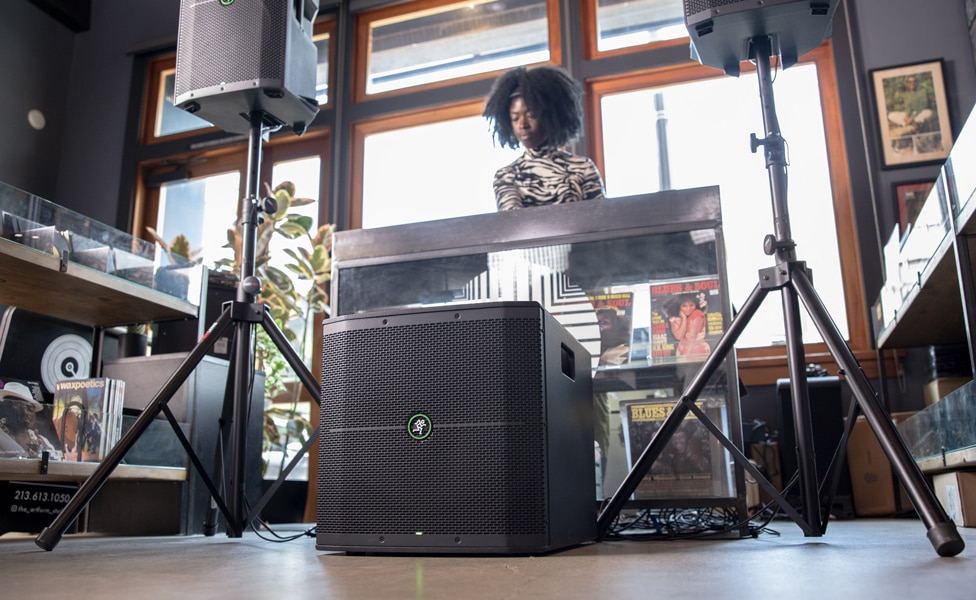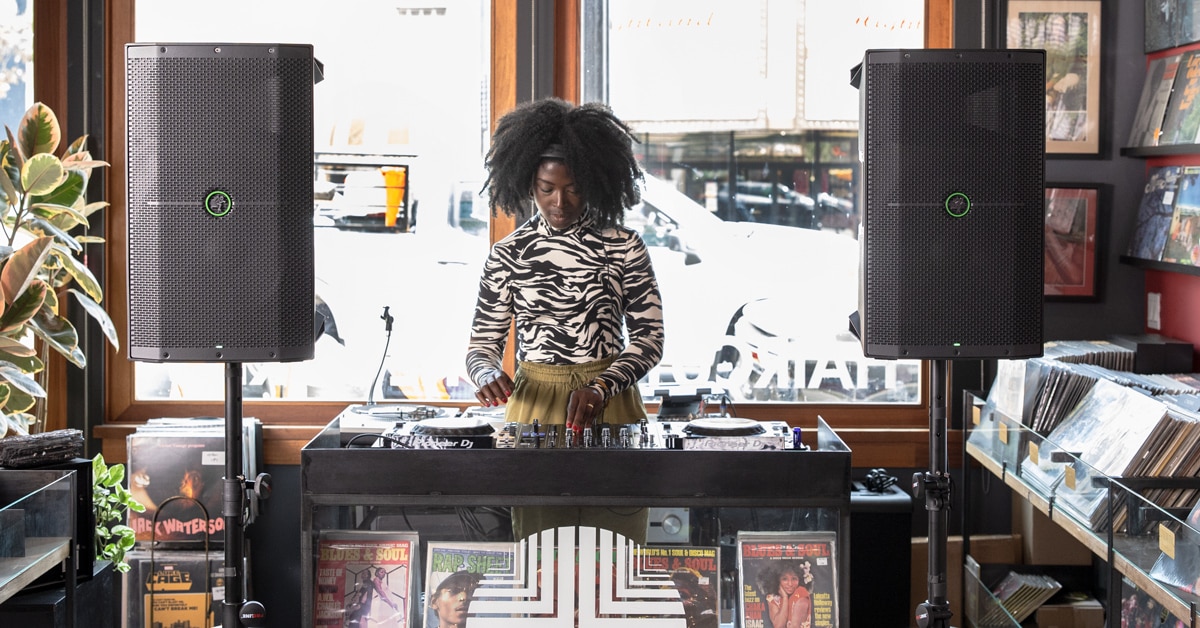Mackie is obsessed with technology. Few Mackie products are frozen in a universe of uniformity because the R&D team is always looking for ways to not just stay competitive with current manufacturing and performance trends, but to innovate beyond what’s expected. The Thump Series of speakers is a great example of this commitment to transformation. Tasked with refreshing the speaker line for 2022, the team didn’t just focus on what could be improved, it engaged in a near-total rethink and upgrade. The result is the standard Thump212 and Thump215 models, Thump212XT and Thump215XT versions with enhanced features, and the Thump115S and Thump118S subwoofers.
All of the new Thump speakers have been bumped up to 1,400 watts of Class-D power, and include large handles and easy-to-grip surfaces for hassle-free transport to gigs. The standard and XT varieties possess savvy automation features such as feedback elimination and music ducking, and the XTs add handy voicing modes (Music, Live, Club and Monitor), Bluetooth connectivity and an outdoor switch that restores much of the sound quality you hear in an indoor venue when performing out in the great wide open. Three clever and functional voicing modes are tailored for the subwoofers: Flat delivers a balanced and un-hyped frequency spectrum, Deep pumps up the bass and Punch adds taut lows and impact to band performances.
Here, Mackie Director of Product Management Matt Redmon—a 15-year veteran of the company, who for the past five years has lead the team for devising the look, feel, performance and sound of Mackie products—takes us on a deep dive into the Thump evolution.
The HUB: How do you assess the competitive landscape to determine how to evolve a product such as this latest generation of Thump speakers?
Matt Redmon: There’s a bit of pattern recognition and life-cycle management that goes on when you work for any technology company, whether it’s Mackie or Apple. Not only are technologies ever-changing, but your competitors are, as well. Loudspeakers are not as fast-moving a category as the automotive industry, where they’re refreshing models every year. Most loudspeaker manufacturers do upgrades or updates every 3 to 5 years. So, it’s always in our plan to refresh a product—even if we don’t yet know what that refresh is going to look like. Still, there are a combination of things that go on during the process.
For example, when a competitor releases a speaker they claim is better than yours, we buy those speakers and reverse engineer them. We determine what we think is the truth, and what is marketing. We focus on our competitive awareness to make sure there’s nothing someone else can do that we can’t.
Then, there’s the customer side of it. We do a lot of in-depth interviews with owners of our products, as well as owners of competing products. We often get a lot of inspiration and ideas from hearing customers share their pain points and wish list items.
The third component is tracking evolving technologies. One of the ways I look at product management is that we are doctors waiting for a pill to exist so we can prescribe it. For us, that “pill” could be WiFi 6 or some other emerging technology that has barely penetrated the consumer marketplace. We look for those advancements so we can put them in our products and remain technically ahead—not just competitive with what’s already in the market.
Sometimes, we find unique ways of doing things. A perfect example is that we were the first brand to figure out how to use Bluetooth—which is an audio-streaming protocol—to control a loudspeaker. That’s now a competitive standard, and it’s a great example of Mackie innovating within the confines of emerging technologies.
The HUB: You’ve improved the overall clarity of the Thump line and increased the total output from 1,300 watts to 1,400 watts. Was this made possible by efficiencies in design, more affordable components, or other factors?
MR: We saw that there were some tweaks and efficiencies we could implement, such as adding capacitors and other little things to get a bit more out of the amp. It’s basically the same amp on steroids—a new version of itself. Basically, it entailed the trend of doing more for less. If you’re going to be competitive in this market, you have to do your part to stay ahead of the trend, because if you don’t, someone else will come to the market with a speaker that’s more powerful than yours.
I don’t want to touch too much on this, but I think the typical Musician’s Friend customer knows that peak wattage doesn’t mean much. With products that advertise more wattage than ours, they know the things to really look at are frequency response and sound-pressure level, and they’ll see that our speakers are certainly one of the most competitive out of today’s offerings—including things that launched 6 months ago.

The HUB: Can you tell us how some other related improvements impact performance in the Thump line?
MR: The waveguide structure came about in our flagship SRM V-Class Series speakers. We were able to bring it down to the SRT Series, and then we were able to mold it into an all-new single-sheet baffle for this latest generation of Thump.
We also lowered the frequency of the horn to 1.8kHz. This is important because the typical loudspeaker crossover point is around 3kHz. Two-way designs are sort of inherently compromised in that you can’t expect a 12" or 15" woofer to accurately reproduce its frequencies all the way up to 2kHz in the same way that a 5" or 6" driver—or even a compression driver—would reproduce them. The lower you can load your horn, the more seamless the crossover, resulting in a smoother, more buttery transition of those frequencies. So, this is the other part that plays into the improvement in clarity.
The HUB: Can you explain the feedback eliminator and music ducking features?
MR: Regardless of the type of customer we spoke to, feedback elimination was the number one request. Feedback is really a big pain point for people dealing with loudspeakers. Now, it would be easy to look at feedback elimination, and say, “Yeah—everybody has that.” But having the experience we do, our algorithms are smart enough to not just identify the offending frequencies and determine how wide of a notch to make, but to also understand if the initial dip is working, then more of a dip can be applied to eliminate raging feedback. In fact, even seasoned live-sound professionals who know how to make feedback happen, will not be able to make a Thump speaker feedback in undesirable way for more than half a second. The algorithm works that fast.
Music ducking is nice to have, as well, and it’s interesting that the vast majority of mixers don’t have any sort of music ducking built in. You have to do it manually at the mixer. But, with a Thump speaker, you could do a whole wedding without a mixer. All you have to do is plug your microphone right into a Thump, and every time you speak, the music track will automatically lower its volume.
We spent a lot of time listening to the fade up and fade down to make sure they were seamless. For the fade down, we wanted it quick enough that you don’t lose intelligibility of even the speaker’s first syllable. We also worked hard to make sure the music doesn’t hit you in the face when a person finishes speaking. It’s a nice, natural ride back up to where the music was originally. And, of course, if a guest speaks and accidently points his or her mic right at the speaker, the feedback eliminator will catch it. So, we’re providing 80 percent of what you need for this kind of use case.

The HUB: You also improved the user interface.
MR: Yes. One of my favorite things we did for the new Thump Series was turn the digital user interface of products such as the Thump Boost into button-for-button controls. For example, I can turn feedback elimination on or off without navigating through any menus. If you choose the enhanced Thump212XT or Thump215XT speakers, you get more control via Bluetooth and the Thump app. When you’re connected to the app, it mirrors the back panel controls and adds a bit more options, such as extra EQ control, storing your settings and recalling snapshots. Simplifying the user interface by making it as low-touch and high-speed as possible was a big leap that we wanted to take.
The HUB: What was the thinking behind the improvements in the subwoofers?
MR: The previous Thump subwoofer has actually been out for more than a decade. We didn’t refresh it along with the rest of the Thump lineup in 2017. Much of this new refresh was driven by customer requests, because people want smaller and more portable setups. So, we moved to a front-firing ported design in order to take down the size of the product substantially without impacting the experience at all. We upped the power substantially, too. The last Thump subwoofer had an older Class A/B amp design that was a bit heavier and produced lower power. The combination of taking the material costs down, and getting a higher-power, higher-efficiency amplifier was key. Of course, making a subwoofer more compact is also about making it more portable. You’ll really notice the handles when you carry the sub into your gig.
Another important aspect of the Thump subwoofers is that they’re time aligned to the top boxes. Because of the way the high-pass filter is handled in the subs, you’re getting a perfectly time-aligned, crossed-over, 3-way sound system that produces a complete, full and clear sound.

The HUB: If a Musician’s Friend customer doesn’t have the opportunity to audition Thump Series speakers in person, can you detail what type of sound and performance they can expect?
MR: Our approach to voicing is making the most musical sound possible—even at ridiculously high volumes. After all, customers have performance and reliability requirements. They want to be able to turn up their speakers real loud, and know they are not going to break. So, part of our development process involves highly accelerated lifecycle testing, where we burn the speakers in at their absolute maximum volume and voltage for more than 100 hours. We make these things bulletproof, so users can trust that no matter how hard they’re overdriving the speaker with signal, they aren’t going to kill them. The loudspeakers will retain their musicality.
The typical symptoms of some speakers are that you get some that distort, and you get some that are honky or shrill sounding. Maybe you can hear the compressor pumping and breathing. There are some speakers where the bass is totally anemic. We have none of that. Even when misused, Thump speakers retain their musicality at all levels.







































































































































